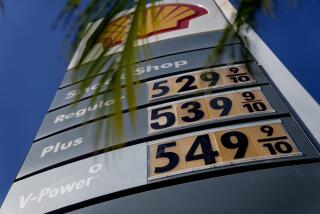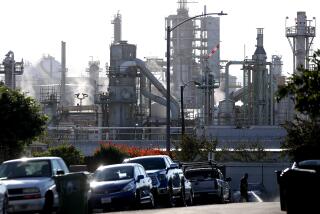Octane’s Allure Hurt by High Cost
- Share via
This year’s soaring gasoline prices pushed droves of drivers to part ways with their premium.
As overall gasoline consumption has increased despite record prices, premium fuel has taken a hit. Nationwide, daily volume of high-octane gasoline sold in the first nine months of this year fell 6.4% from the same period last year, while purchases of mid-grade gasoline dropped 3.6%, according to the Energy Information Administration, an arm of the Energy Department. The volume of regular gasoline sold rose 4.3%.
“Every time the price goes up, the premium [volume] goes down,” said Mike Madani, who owns a Shell station in Redondo Beach. “The people who use premium go to mid-grade, and the people who use mid-grade go to regular.”
The shift was pronounced at Madani’s station, which caters to an unusually large base of premium buyers. September’s post-hurricane surge in retail gasoline prices cut his sales of high-octane fuel by 3%, a significant loss because premium provides more profit than regular.
Switching to a cheaper, lower-grade fuel -- or “buying down” in dealer parlance -- is a common consumer reaction to sharp jumps in retail pump prices. But with each cycle, only some of the octane-hoppers return to the pricey stuff, and that accelerates a long-term trend away from premium, said David Portalatin, an auto industry analyst at NPD Group, a Houston-based market research firm.
“There are people out there that are encouraged to try a lower grade to save a little bit of money, and when they do so, the average driver doesn’t discern a difference,” Portalatin said. “So they think, ‘Hey, there’s really no reason to go back.’ ”
Nationwide, only 7% of consumers said their last gasoline purchase was premium grade -- a new low, according to an NPD survey of fuel purchases through October. A decade ago, consumers shelled out extra money for premium about 19% of the time, Portalatin said.
Today’s premium fuel -- gasoline with an octane rating of 91 or higher -- typically costs about 20 cents a gallon more than 87-octane regular. Mid-grade fuel, with 89 octane, usually splits the difference in price.
The higher-octane gasoline provides greater resistance to the uncontrolled fuel burning that can cause engine knocking or pinging.
Automakers and fuel experts don’t dispute the properties of premium, but they point out that most vehicles come with sensors that allow the engine to adjust to different grades of gasoline without a noticeable loss of power or performance.
David E. Cole, chairman of the Center for Automotive Research in Ann Arbor, Mich., said some car manufacturers, especially makers of luxury and sports cars, list premium fuel as a requirement in the owner’s manual. In such cases, he said, it’s usually a good idea to stick with the top-grade fuel.
However, the majority of today’s vehicles are designed to run on regular, and even those models where the manufacturer recommends higher octane fuel generally run just fine without it, Cole said. Deviating from the gas dictated or recommended by the auto maker can sometimes cause a drop in fuel economy, but it’s unclear whether the loss is enough to offset the higher cost of premium fuel, he added.
“In most cases, I view buying premium fuel as throwing money away,” Cole said. “I buy regular fuel. I think it’s the best deal, and it’s not going to hurt your car.”
None of that is good news for oil companies that have made a point of pushing their premium blends in an effort to boost profits as well as brand loyalty.
East of the Rockies, BP peddles an ultra-premium gasoline, the 93-octane Amoco Ultimate, to lure motorists away from competitors. Shell Oil Co., which launched its V-power high-octane fuel last year amid unusually high gasoline prices, touts its fuel’s engine-cleaning ability.
Also in the promotional toolbox: purported environmental benefits, improved fuel economy and better “drivability.” But the marketing efforts are undermined by Consumer Reports and car experts who routinely tell the motoring public that premium gasoline is usually not worth the extra cost.
For oil companies today, “I think success is measured in a reduction of attrition, not in growth in the customer base,” said Tom Kloza of the Oil Price Information Service, an energy research company.
Still, premium fuel has a devoted -- even emotional -- following, especially among car enthusiasts, Cole of the auto research group said. “There are people who absolutely wouldn’t use anything else.”
BP considers those drivers the core market for premium. “A lot of people are passionate about their cars.... They spend a lot of money on products to enhance performance,” said BP spokesman Scott Dean. “It’s a group that we think is very important to market to.”
In addition, there are many premium buyers among wealthy owners of luxury cars. As Cole said, “If someone’s driving a Mercedes S-class, then chances are that the price difference between premium and regular doesn’t mean anything to them.”
Oil companies can also count on a large share of the motorcycle crowd, because they typically have high-compression engines that need premium fuel and don’t have the ability to adjust to lower-octane grades, Dean said.
After a half-year of sustained highs, Hurricane Katrina sent gasoline prices screaming past the $3-per-gallon mark in September. The national average for premium hit a peak of $3.285 a gallon, and in some areas high-octane prices approached the $4 mark.
Since then, retail prices have dropped steadily. The nationwide average for premium was $2.408 a gallon on Nov. 21, down nearly 90 cents from the record high of early September, according to the government’s weekly survey.
If oil companies hope to recapture lost premium customers, now is the time to strike, said Kloza, the director for editorial content at the oil price service. He expects the cost of gasoline to jump again next spring and to stay high through the summer.
“The next 120 days will probably be one of the last big chances to get people to come back to premium and get used to it again,” Kloza said. “It’s a lot easier to sell premium when the price is considerably less than they paid for regular just a few months ago.”
Madani and his dealer colleagues are hoping for a strong resurgence in premium sales. But even he is reluctant to shell out the extra cash for it.
He puts regular in his wife’s sport utility vehicle even though the owner’s manual recommends mid-grade.
And when he’s unable to tap his own station’s pumps, Madani said, “I put in the cheapest gas that I can find. It’s a natural human instinct.”
*
(BEGIN TEXT OF INFOBOX)
Downshifting to regular
High prices have motorists buying more regular gasoline and less mid-grade and premium.
Gallons of gasoline sold in the U.S., January through September each year(In billions)
Regular
2004: 86.7
2005: 83.4
*
Mid-grade
2004: 6.8
2005: 7.1
*
Premium
2004: 10.7
2005: 11.5
Source: Energy Information Administration
More to Read
Inside the business of entertainment
The Wide Shot brings you news, analysis and insights on everything from streaming wars to production — and what it all means for the future.
You may occasionally receive promotional content from the Los Angeles Times.










